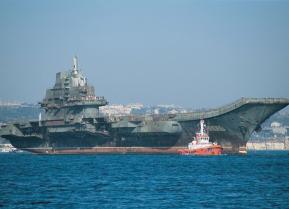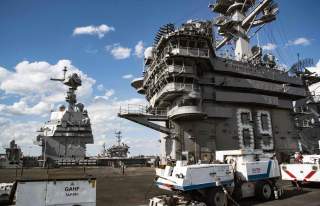These Are All of the Ways Not to Build an Aircraft Carrier
Just how expensive is the Navy's new Ford-Class Carrier?
Explosives are detonated underwater in relatively close proximity to the ship in order to learn if the ship’s systems are sufficiently hardened to carry out missions in the rigors of combat conditions, and if the crew would be able to rapidly identify and fix any problems that resulted during those conditions.
The Navy first identified the need for such testing in World War II. It was observed that several newly designed ships were rendered useless because of “inadequate shock proofing of the ship systems” when mines or torpedoes merely exploded nearby.
Since then, the Navy has required that shock hardness be “designed and engineered into ship platforms, aircraft and shipboard interface systems, ordnance and related equipment.” The official Navy instructions for ship-hardening lists 16 mission-essential systems that must continue functioning after a shock event, including propulsion, navigation and communications.
Thousands of components are put to the test. During shock trials for the Arleigh Burke-class destroyers, for instance, 4,460 unique components were monitored.
Navy rules used to require the first-in-class ship to go through shock trials. Despite the obvious importance of verifying shock-hardening, the Navy changed its rules in 2013. Now the Program Executive Officer for each ship class may select the first-in-class ship “or an early ship of each shock hardened class that shall be subjected to the shock validation process as part of post-delivery test and trials when required.”
The timing of the rule change is important within the context of Ford and the subsequent ships in her class — on June 18, 2012, the Navy attempted to abandon its plans to conduct Full Ship Shock Trials on the Ford, claiming that deferring the tests to a later ship was justifiable because components like the EMALS and AAG were shock hardened by design.
Instead, the Navy announced its intention to conduct the shock trials on Kennedy. The Navy altered the testing plan while its own instructions still mandated the tests be conducted on the lead ship. It wasn’t until eight months later that the Navy issued its new instructions regarding shock trials.
The Navy met with resistance on the change of plans for the Ford from the DOT&E, which disapproved Ford’s Test and Evaluation Master Plan. The plan didn’t sit well with the two senior members of the Senate Armed Services Committee, either. Senators John McCain and Jack Reed both objected, saying that sending the ship out to sea before the tests “and potentially fighting without this testing gives us pause.”
In the end, Deputy Secretary of Defense Robert Work, under pressure from SASC, overruled the Navy and ordered Ford to undergo shock trials, saying the tests “will be conducted to ensure the survivability of the CVN-78 design is understood prior to beginning operational deployments.”
It is particularly important that Ford go through early shock testing because of its multiple new, high-risk systems, all of them critical to the carrier mission but particularly susceptible to shock and battle damage. These vulnerable, unproven systems include the highly automated A1B nuclear reactor, the EMALS catapults, the AAG arresting gear, the ultra-high 13,800-volt electrical distribution system, the dual-band radar and the new main turbine generators.
Postponing the test to the second ship in class is fraught with risks and potential costs. Had the Navy’s change in plans gone unchallenged, the shock trials to confirm whether the ship’s design could operate successfully in combat conditions likely wouldn’t be completed until 2025. The Navy would run the risk of sending the $13-billion Ford with 4,300 crew members into a situation where a single close-proximity explosion could render it useless and vulnerable to being sunk.
Moreover, if the tests reveal fundamental design problems when they are finally completed, the Navy would have to engage in an expensive retrofit of Kennedy and Ford. In fact, by the time the deferred tests would take place, construction of the third-in-class ship, Enterprise, would be well underway and it, too, would need expensive retrofitting.
The decision to test Ford as originally required was a clear — though unfortunately reversible — victory for long-time advocates of realistic combat and live-fire testing. The whole saga is a clear example of how and why the services and contractors work to thwart the testing process.
The MITRE Corporation, a federally funded research and development center, published a report titled Navy Ship Underwater Shock Prediction and Testing Capability Study that found service officials and contractors with an interest in rushing ships into full scale production — namely, the concurrency advocates — often want to avoid this kind of realistic combat testing.
“Shock trials cost time and money, and [Full Ship Shock Trials] occurs at exactly the time where there is the least incentive to go back to the drawing board to fix any issues that arise.”
Certainly, until the trials are completed, DoD officials and Congress need to maintain vigilant oversight to ensure the ship’s combat suitability is properly tested and evaluated before it enters service.
Actual utility of aircraft carriers
And then there is the overarching matter of the actual relevance of aircraft carriers in the future. Plenty of frank commentators have questioned in recent years whether the day of the supercarrier has passed. The wisdom of investing such a large amount of capital into a single weapon system deserves scrutiny.
There is the basic matter of battlespace economics. Ford costs nearly $13 billion so far. In a few years, she will likely carry a complement of at least 50 F-35Cs. Conservatively, each aircraft will have a real cost of $185 million … for a total of $9.25 billion worth of strike aircraft concentrated on one ship.
That means this one ship when underway will be worth at least $22.25 billion, to say nothing of the 4,297 sailors on board. That is putting a great deal of proverbial eggs in a single basket.
Closely related is the economics of fleet size. Even within a reasonably growing budget, it is impossible to expand the fleet while buying four or more carriers at $13 billion a pop, each with $9 billion of fighters aboard. The Congressional Budget Office estimates the Navy would need a budget increase of one-third to achieve its current shipbuilding goals. To persist in buying four Ford-class carriers guarantees that the fleet will continue shrinking for years to come.
Supercarriers and the vessels that accompany them in the Carrier Strike Groups do carry a great deal of destructive power, at least against fixed land targets and ships that are not too heavily defended. But, simultaneously, they are very large and costly targets.
The United States currently has 10 such carrier groups, but because of the heavy maintenance and crew training required to keep them operating, only a few can be at sea at any one time. This doesn’t provide the United States with a great deal of redundancy.
For this reason alone the president and the theater commanders will be forced to limit their carrier demands in order to husband this precious resource. Today the Navy’s carriers are almost constantly in the news as presidents use them as a symbol of strength anytime there is a potential hot spot around the world. They have become, in effect, a very expensive version of gunboat diplomacy.
Only recently, when the North Koreans renewed threats to conduct nuclear missile tests, the Trump administration ordered a carrier strike group towards the peninsula. This is relatively easy to do, so long as there is little risk that the waters will be contested.
Presidents and theater commanders will likely be far less interested in positioning these same ships where they may be within reach of a potential adversary’s forces. And because other nations see the Navy’s carriers as a centerpiece of American military power projection, for at least half a century potential adversaries have been developing and deploying weapons to keep U.S. aircraft carriers from getting close enough to their coasts to bomb their territory.
Their most important and effective anti-carrier weapons continue to be diesel subs, sea-skimming high-speed anti-ship missiles and mines, all of which are deployed in sizable numbers by every nation with a threatened coast line, particularly Russia, China, North Korea and Iran.
Most potential adversaries have impressively large fleets of diesel-electric subs — North Korea has approximately 70. China has approximately 50. Russia has 18 plus 22 nuclear attack submarines. And even Iran has 20. Clearly, they decided years ago that subs would be their best bet for neutralizing or sinking American carriers.
Thirty years of Navy fleet exercise results bear them out:
To put it simply, if naval exercises in the last two decades involving foreign diesel-electric submarines had been actual combat, most if not all, U.S. aircraft carriers would be at the bottom of the ocean: as many as 10 U.S. aircraft carriers have been reported ‘sunk’ in these exercises.
The analytically conservative Congressional Budget Office was alarmed enough to officially report that ‘some analysts argue that the Navy is not very good at locating diesel-electric submarines, especially in noisy, shallower waters near coastal areas. Exercises with allied navies that use diesel-electric submarines confirm that problem …
[For example,] Israeli diesel-electric submarines, which until recently were relatively old, are said to always ‘sink’ some of the large and powerful warships of the U.S. Sixth Fleet in exercises. And most recently, an Australian Collins-class submarine penetrated a U.S. carrier battlegroup and was in a position to sink an aircraft carrier during exercises off Hawaii in May 2000.’
There have been many such exercise ‘sinkings’ since then, including aircraft carriers Reagan and Lincoln.


